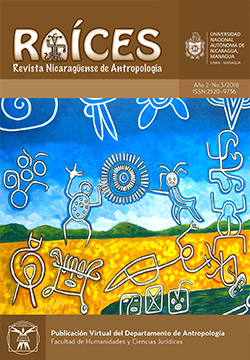Influence of the border on the dynamics of the process of local conformation of Cárdenas, in the historic region of Rivas, Nicaragua. Historical and social implications of the border
DOI:
https://doi.org/10.5377/raices.v2i3.6903Keywords:
Border, multidisciplinary studies, locality, regional studiesAbstract
The study of borders has had a great boom especially in recent years in Latin America and the Caribbean. In the case of Central America, the borders have been considered as zones of conflict between the countries that share them. Historically, these have not received attention from the State, remaining forgotten and attended only when new border or territorial conflicts appear. In other diverse fields of social and human sciences, the notion of frontier is taken into account in a broader sense and is not systematically translated into the boundaries between states. The term is used to express a separation between cultural groups (linguistic, religious border) and is associated with a confused, imprecise, mobile contact. The border has the ability to directly affect the configuration of the towns, cities and towns that develop along it. However, this capacity for influence is divergent and discontinuous due to various factors of a historical, geographical, socioeconomic and political nature. The present investigation has the purpose of producing a work that deals with the study of the locality of Cárdenas and its border regions, understanding them as those spaces of transcendence for the development of these and of Nicaragua, from an integrating and multidisciplinary perspective.
Downloads
References
Alcaldía municipal de Cárdenas. (2012). Caracterización de Cárdenas. Cárdenas.
Bottino Bernardi, M. (2009). Sobre límites y fronteras. Rivera-Santa Ana do Livramento. Estudios históricos, 1-18.
Bovin, P. (2005). Las fronteras del istmo. Fronteras y sociedades entre el sur de México y América Central. En F. Kinloch Tijerino, Conflictos limítrofes y discurso nacionalista. La frontera Nicaragua-Costa Rica (1824-1858) (págs. 97-107). México D.F.: CIESAS.
Códigos de la legislación de Nicaragua. (1881). Supresión de la escuela de Tortuga. Tipografía Nacional. Recuperado el 17 de diciembre de 2015 en http://enriquebolaños.org
Códigos de la legislación de Nicaragua. (1917). Ejidos para Cárdenas.
Tipografía Nacional. Recuperado el 17 de diciembre de 2015 en http://enriquebolaños.org
(02 de Febrero de 2016). Entrevista a grupo focal habitantes La Libertad y San Fernando. (J. Romero, Entrevistador)
Espinoza, O. (2015). Migración no documentada de nicaragüenses hacia Costa Rica. Managua.
Forestal, M. A. (2013). Departamento de Rivas y sus municipios: Uso de la tierra y el agua en el sector
agropecuario. Managua: MAGFOR.
Granados, C. (1999). Las fronteras centroamericanas: Espacios de encuentros y desencuentros . San José: FUNPADEM-UCR.
Hagget, P. (1988). Geografía. Una síntesis moderna. Barcelona: Omega.
Instituto Nacional de Información de Desarrollo. (2007). Caracterización sociodemográfica del Departamento de Rivas. Managua : INIDE .
Instituto Nacional de Información de Desarrollo. (2014). Anuario Estadístico 2014. Managua: INIDE.
Ley No.749. Ley de régimen jurídico de fronteras. Publicada en La Gaceta Diario Oficial. No.244, del 22 de diciembre de 2010. Nicaragua.
Morales, R., Rodríguez, A. C., & Calderón, J. (2013). Proyecto de investigación: Integracion no formal o real: Cordón Transfronterizo Guanacaste (Costa Rica) y Departamento de Rivas (Nicaragua). La Cruz: UNED.
Municipal, I. N. (s.f.). Caracterización municipio de Cárdenas. Managua: INIFOM.
Naturales, M. d. (2000). Plan Ambiental Departamental de Rivas . Managua: MARENA.
Ortez, M. A. (2 de Diciembre de 2015). Entrevista lider de cooperativa comarca Colón. (M. Villalta, Entrevistador)
Rivas, A. d. (2010). Plan departamental de Ordenamiento y Desarrollo Territorial de Rivas. Rivas.
Venegas, Hernán. (2007). La región en Cuba. Provincias, regiones y localidades. La Habana: Ed. Félix Varela.




